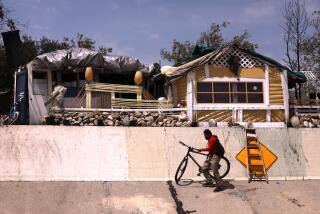Homeless crisis in L.A. inspires some purposefully small ideas: tiny houses
- Share via
Mayor Eric Garcetti asked, and the answer was yes.
Can students from design schools try to come up with ideas to help address homelessness in the city? The results were recently unveiled at the Main Museum downtown.
The three full-scale prototypes and a number of miniature models were the work of students completing a two-term studio project with James Meraz, a professor of environmental design at ArtCenter College of Design in Pasadena.
Their challenge was to design emergency temporary housing. Also known as bridge homes, these structures are meant to house the homeless in any given location for up to 36 months before the structures are moved to help people in need somewhere else. The idea is to establish a refuge until residents can be connected with a more permanent home.
While working on their designs, students spent time on skid row, talking with residents, absorbing the neighborhood and cooking food for 110 women at the Downtown Women’s Center.
You can’t remove politics from design on this level at all.
— James Meraz, professor of environmental design at ArtCenter College of Design
“You can’t remove politics from design on this level at all,” says Meraz, opening the door to a prototype named Nest that was built for $1,700 and features a single bed, a small desk and chair, a lamp and three shelves. “And we immediately got thrust into the NIMBY idea that people don’t want this.”
The not-in-my-backyard argument got thrown around quite a bit when Garcetti proposed using a city-owned parking lot in Koreatown for a temporary homeless shelter. The lot in question was the site that Garcetti originally asked Meraz and his team to create designs for.
Upstairs in the Main, Meraz shows a model for what that lot would have looked like if his class’ designs had been allowed to reach fruition. The result looks like a tidy future city filled with micro-dwellings arranged in groups of three, with communal areas for bathing and cooking, and paths for biking and walking.
The idea is preferable to the soiled tents and tattered tarps that line sidewalks and underpasses across the city, says Meraz, lamenting how community protests torpedoed any chances for the Koreatown site to host his students’ work.
His optimism far outweighs his pessimism, even though none of the city officials who originally asked for these designs had yet to see them at the museum. Deputy Mayor Brenda Shockley, who attended early presentations, says she is planning to look at the prototypes after Christmas.
(On Friday, Main Director Allison Agsten announced that she and her team were leaving the museum by year’s end, and that ArtCenter and Main founder Tom Gilmore were discussing future plans for the space. An ArtCenter spokeswoman confirmed “ongoing discussions” but declined further comment; The Times has reached out to Gilmore for more information.)
For Meraz and his students, the idea was to create dwellings with dignity. Places that felt private and secure, where the homeless could enjoy a sense of community without having to bunk with others.
“These all have front doors, and they all have the idea of an address,” Meraz says, showing off the tiny front stoop complete with a motion-activated porch light and keyed door lock of the Pop Hut, which was built for about $2,000. “These are all small emotional things that make you feel like you have your own domain.”
An estimated 34,000 homeless people live in Los Angeles, and 24,000 of them are unsheltered. Tiny houses alone won’t solve the crisis, of course, but the ArtCenter project does widen the conversation about potential solutions, especially when it comes to two big emerging populations: people who are experiencing homelessness for the first time, and women between 45 and 55.
It was the plight of women that really spoke to students Kristy Chi and Rachel Zhang, who created a third prototype named Merge. Merge is the largest and most expensive model, built for about $6,000. But Meraz points out that because of digital fabrication, it could be produced as a kit in a factory and the cost would come down significantly.
Merge looks like a large midcentury modern toaster made of plywood. It has soft curved edges, a large bed that could sleep a mother and child, a mirror and foot-pump sink, solar lighting with a battery pack for charging a phone, and a small shaded outdoor area to hang a hammock or store a bike.
Chi, who is studying product design, says that she was particularly struck by the fact that women on skid row feel immensely vulnerable and seem to live perpetually in fear.
“They are invisible, nobody stands up for them,” Chi says. “A woman needs to feel security, like she is in a safe place.”
Meraz and Chi aren’t sure what will become of the studio’s designs, but they are happy that the prototypes are out in the world. They hope that the structures provide food for thought, particularly among people of a NIMBY mind-set.
“It makes me crazy,” Meraz says of opposition to sheltering the homeless on city-owned lots. “This is good design that would be out there. People wouldn’t be upset by this.”
♦ ♦ ♦ ♦ ♦ ♦ ♦ ♦ ♦ ♦
‘Sanctum: Micro-Dwellings for L.A.’s Homeless’
Where: Main Museum, 114 W. 4th St., L.A.
When: By appointment only
Admission: Free
Info: (626) 396-2223
ALSO:
Furor is mounting over proposed Koreatown shelter
A closet of her own: Deeply personal exhibit at the Skirball examines one woman’s quest for freedom
Academy Museum reveals what you’ll see inside
More to Read
The biggest entertainment stories
Get our big stories about Hollywood, film, television, music, arts, culture and more right in your inbox as soon as they publish.
You may occasionally receive promotional content from the Los Angeles Times.











